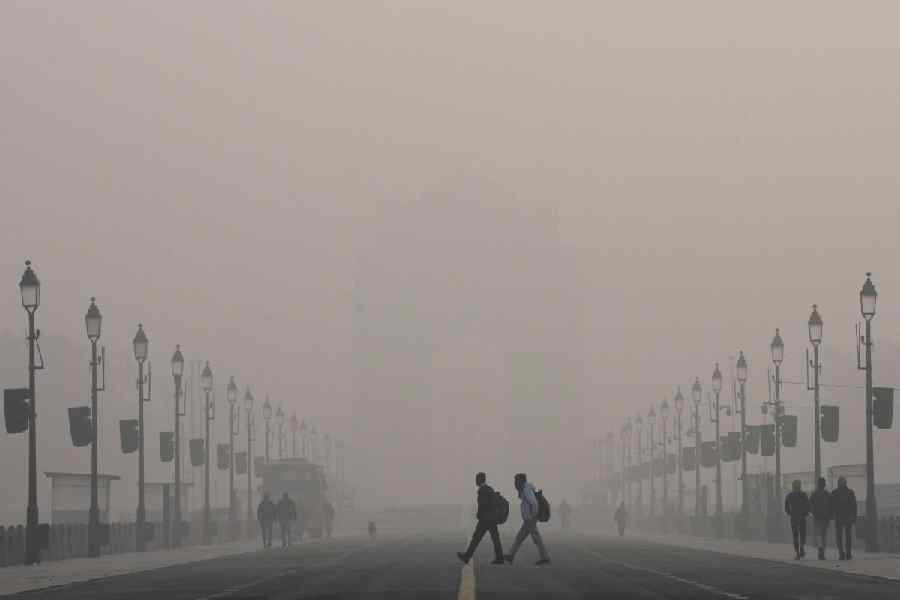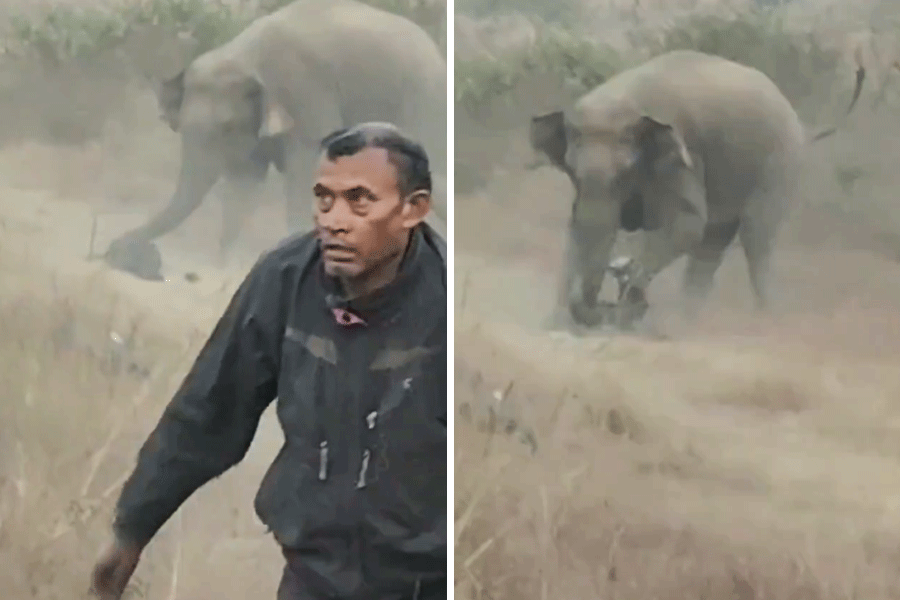


.jpg)
When the cobra bit Utpal Mondal, it was close to midnight. "I had stepped out of my hut," says the 32-year-old farm labourer from Poramura village near Canning, the gateway town to the Sunderbans, about 57 kilometres from Calcutta. "It was dark. I thought I had stepped on a wet rope," says Mondal. The next thing he knew, the rope was coming at him. He tried to shield himself with his hands and it sank its fangs into his right ring finger. As the sting burnt through his body, he watched the creature slither away, its salt-and-pepper speckles clearly visible in the glow of the street lamp.
Mondal's screams of " keute" or cobra woke up his wife and children. Some neighbours also rushed out of their huts. An elderly relative suggested that an ojha - also known as roja, basically a faith healer - be summoned. But a teenaged nephew decided to call the 24/7 local helpline instead. Through the engulfing pain and dizziness, Mondal remembers someone asking him to describe the snake. He remembers how his own voice sounded hoarse and his speech, slurred. By the time he was lifted onto a motorbike ambulance and transported to the Canning sub-divisional hospital, he had lost consciousness.
At the hospital, doctors put him on saline drip. They also injected 70 vials of snake anti-venom to neutralise the neurotoxin or poison that had entered Mondal's bloodstream. A volunteer from the Canning Juktibadi Sanskritik Sanstha or CJSS, an organisation working to spread awareness about snakebites, kept vigil.
Thousands of people in India die of snakebite every year. But it is the problem of the "other" India. It affects farmers, farm labourers, cowherds and their families. Available data probably underplays the depth of the problem; snakebite cases are grossly unreported and scant attention given to improving our knowledge of them because it is classically a poor man's affliction. The World Health Organization has recently named snakebite among the most-neglected of tropical ailments. The deaths don't always have to do with the bite itself. Cures and anti-venoms abound. One obstacle is infrastructure - roads to the nearest hospitals are bad or non-existent. Often hospitals also lack the requisite storage facility and, therefore, do not have enough life-saving medicines in stock. But the real killers are ignorance and superstition.
That night when the snake bit Mondal, Kabil Jamadar, an ojha-turned-bigyankarmi or volunteer with the CJSS, was manning the helpline. He says, "I was born into a family of ojhas. But after I attended an awareness camp organised by CJSS, I quit." At the camp, CJSS workers threw a challenge to all ojhas - cure a goat stung by a gokhro or King Cobra. The prize money was Rs 50,000. Some chanted mantras, some sprinkled "holy" water, many applied herbal extracts; no one was able to revive the goat. CJSS volunteers then injected another goat, also stung by a King Cobra, with a few vials of anti-venom and revived it. One goat had to die but the point was established. Says Jamadar, "They demonstrated the futility of our black magic in case of poisonous bites."
Only one out of 10 snakebites is poisonous. At other times, poisonous snakes plant dry or non-poisonous bites on its victims. Jamadar and some of the other ojhas, who now know better, treat these with first-aid and painkillers. If a bite is poisonous, they carry the victim to the nearest health centre. But these are exceptions.
Vishal Santra, a herpetologist (one who studies reptiles and amphibians) based at Nalikul in Hooghly, often gets into squabbles with ojhas. Santra, who is the founder of the Simultala Conservationists Foundation (SCF), conducts workshops on snake identification and diagnosis of snakebites. He also provides training programmes in villages to address human-snake conflicts. He says, "In several instances, we have to literally snatch the victims from the clutches of the faith healer. It is not easy. Often they have strong political clout."
The ojhas are the ones who perpetrate myths and falsehoods about snakes and snakebites. And despite awareness camps organised by rationalists such as Santra, a majority of the 50,000 or so people who die of snakebite every year prefer to consult them. Dr Omesh Kumar Bharti, an epidemiologist (scientist who studies diseases) at Shimla, Himachal Pradesh, believes it is not just blind superstition that makes people rush to faith healers. "It's a cheaper option. Although anti-venom comes free at government hospitals, in people's minds it is an expensive treatment. Besides, health centres are often far flung, inaccessible."
Bijon Bhattacharya, founding secretary of CJSS, sounds exasperated. He says, "There is no law that can stop faith healers." According to him, such dogmas of faith have been instilled over thousands of years and abetted by Hindi films and television programmes.
In August, the serpent goddess Manasa will be worshipped across villages and mofussils of eastern India. The story of Manasa coming to the aid of snakebite victim Lakhindar and his wife, Behula, will be reiterated. Rationalists have found a way of using the old narrative to put across a new point. The snake that bit Lakhindar and is described in Manasamangal Kavya was a kalnagini or Chrysopelea ornate - a mildly venomous snake incapable of killing any human. Santra, who holds campaigns across remote villages to demystify snakes, says, "We try to explain that Manasa was a herpetologist who just wanted to scare Lakhindar's father, Chand Saudagar. She had no intention of killing Lakhindar. [To settle scores with Chand Saudagar, who was a worshipper of Shiv, Manasa had unleashed havoc. Among other things she had ordered the kalnagini to bite Lakhindar]."
Sometimes rationalists succeed, but many a time their efforts are thwarted by religious outfits that resent such reinterpretation. They feel the "atheist" agenda is detrimental to "religious freedom".
Dr Dayal Bandhu Majumdar, an eye-specialist at the Calcutta National Medical College, is also a medical crusader. According to him, even doctors are to blame for the high number of snakebite fatalities. He tells you that the MBBS syllabus makes just a passing reference to snakebites. "Most fresh medical graduates do not know that the common krait bites painlessly when the patient is asleep - leaving no visible sign on the body. The victim complains of a seemingly innocuous abdominal pain which can gradually turn into convulsions and acute respiratory distress." Volunteers of CJSS and SCF stationed at rural hospitals often guide junior doctors in diagnosing and treating snakebites. Majumdar has helped create a treatment protocol that has now been distributed among medics at health centres across the state. Bharti, the epidemiologist from Shimla, advocates stocking anti-venoms in ambulances along with other life-support equipments.
Mondal, the farm labourer who was saved after the cobra bite, has learnt the "terrifying reality" of snakebites. Now he has turned into a bigyankarmi and works at awareness campaigns across villages around Canning. "I try to make them aware about the rational treatment of snakebites. I also tell them to stay away from ojhas," he says. In such campaigns, Mondal is often accompanied by Jamadar, the ojha who helped save his life. A reassuring double dose.
Gang of Four
Snakes that cause the most deaths
Common Krait (Karait, Kalach, Domnachiti, Chitti): Its bite is painless but its venom induces paralysis and subsequent death
Indian Spectacled Cobra (Keute, Naag): Revered in myths and popular with snake charmers, its venom destroys blood cells and triggers bleeding. Could lead to brain haemorrhage
Russell’s Viper (Chandrabora, Chandanboda): The most dangerous of all. It harms even if you survive the initial bite. The venom can affect the kidney in the long run
Saw Scaled Viper (Fursha): Widespread in remote areas. Generally active after sunset











